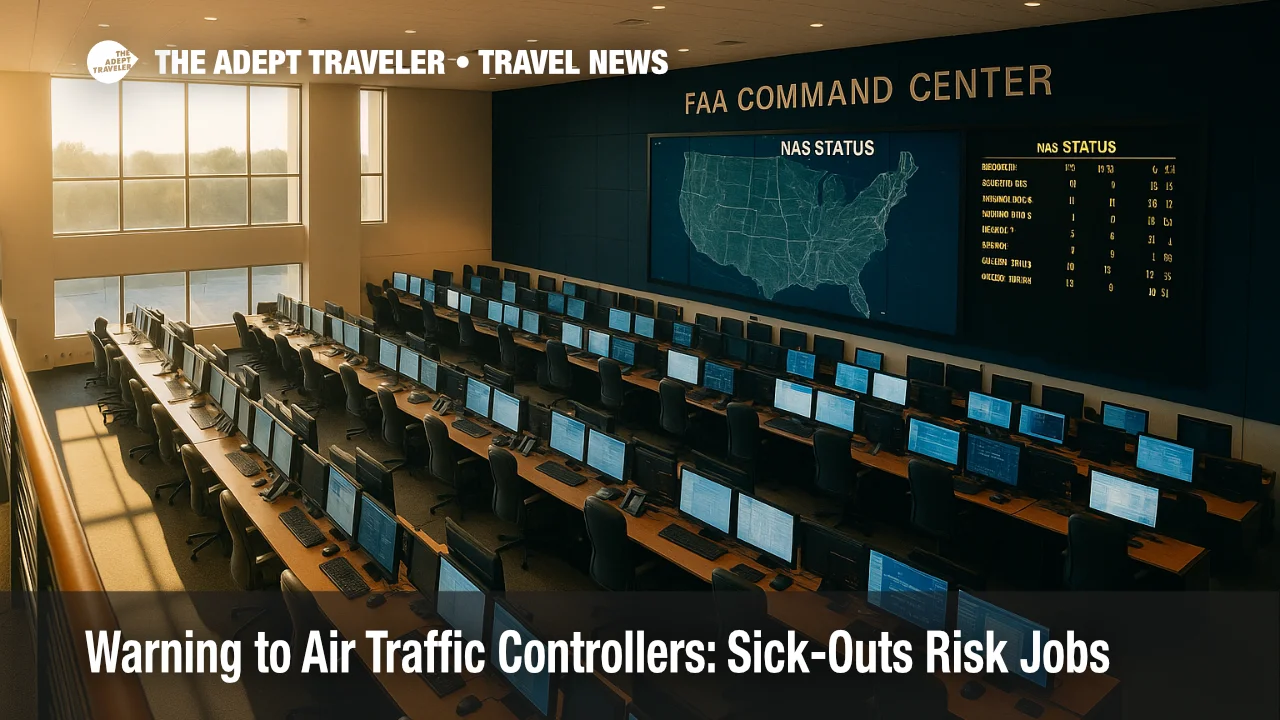Warning to air traffic controllers: sick-outs risk jobs

Transportation Secretary Sean Duffy warned that air traffic controllers who call in sick during the federal shutdown could be dismissed, saying even a small number of absences can ripple across the system. He praised most controllers for continuing to work unpaid, but labeled chronic absences "problem children," citing a jump in staffing-related delays nationwide. On October 9, Newark Liberty International Airport (EWR) saw extended ground delays amid reported staffing triggers, while facilities from Burbank to Nashville also experienced disruptions.
Key points
- Why it matters: Duffy said sick-outs during the shutdown may cost controllers their jobs.
- Travel impact: Staffing-linked delays surged from a typical 5 percent to 53 percent, slowing arrivals.
- What's next: FAA will meter traffic when staffing dips; travelers should plan buffers.
- Newark, Burbank, Nashville, and D.C. reported notable slow-downs this week.
- FAA still faces a roughly 3,500-controller shortfall versus targets.
Snapshot
Duffy's remarks aired October 9 on Fox Business, where he said the vast majority of air traffic controllers are "amazing patriots," but a small fraction not showing up can snarl operations. He warned repeat offenders could be let go even as the agency leans on mandatory overtime to keep the system moving. According to Duffy, staffing-driven delays now account for 53 percent of all U.S. delays, up from a pre-shutdown norm near 5 percent. The National Air Traffic Controllers Association has urged members to keep working and warned that coordinated "sickouts" are illegal and could lead to removal from federal service.
Background
The shutdown began October 1 and has left essential personnel working without pay, including approximately 13,000 controllers and 50,000 TSA officers. Controller staffing has lagged for years due to retirements, training bottlenecks, and pandemic impacts. DOT says the FAA remains about 3,500 controllers short of targets, though it touts progress on hiring in 2025. During the week, Command Center advisories cited "staffing triggers" at multiple facilities, prompting ground-delay programs to keep operations safe. NATCA reiterated that any job action is illegal and undermines safety. These dynamics echo the 2019 shutdown, when mounting delays helped push a political resolution.
Related reading: FAA staffing shortages slow flights as shutdown deepens and Flight delays and airport impacts: October 10, 2025.
Latest developments
Newark delays underscore staffing strain
On October 9, Newark recorded ground delays as FAA advisories and live ops pages flagged staffing-related constraints. Local reporting counted dozens of delayed flights by early afternoon, while aviation trackers showed rolling holds and extended taxi-out times. Separate reports highlighted Hollywood Burbank Airport (BUR) operating with limited tower staffing earlier in the week, and Nashville International Airport (BNA) facing multi-hour arrival delays during peaks. FAA's Command Center indicated additional "staffing triggers" across Northeast and Mid-Atlantic sectors, with metering used to maintain safe arrival rates. Travelers connecting through congested hubs should expect gate holds and slower pushbacks until appropriations resume or staffing stabilizes.
Analysis
Duffy's "work or lose your job" warning is aimed at deterring illegal job actions while reassuring the public that FAA will keep flights safe. The immediate operational lever is metering: reduce arrival rates so fewer planes enter constrained airspace, shifting delays from the sky to the gate. That preserves safety margins but pushes pain to passengers through longer waits and missed connections. Newark's congestion demonstrates how a single high-demand hub can compound nationwide, especially when feeder facilities are short-staffed.
The policy challenge is two-fold. First, the shutdown removes paychecks and predictability, increasing fatigue and absenteeism risks in an already thin workforce. Second, the structural shortfall persists; even with improved 2025 hiring, the academy pipeline and on-the-job certification take years. NATCA's guidance against "sickouts" aligns with safety priorities, but morale and affordability pressures mount the longer a shutdown lasts. Expect the FAA to continue targeted ground-delay programs at pressure points such as Reagan National, Newark, and Nashville, alongside expanded overtime. For travelers, the practical response is adding buffer time, favoring morning departures, and monitoring EDCT updates from the FAA and their airline apps.
Final thoughts
Air traffic controllers remain the backbone of the system, and most are still working unpaid. But as the shutdown drags on, staffing-linked disruptions will continue, and enforcement rhetoric may intensify. Until funding is restored and hiring gains translate to certified staffing, expect periodic metering at key hubs and leave extra time, especially through Newark, Washington, and Nashville. The safest bet for now is to build buffers, track advisories, and understand that the shutdown has made air traffic controllers the critical constraint in U.S. air travel.
Sources
- U.S. could dismiss air traffic controllers who fail to work during shutdown, Reuters
- Duffy hints at firing air traffic controller 'problem children,' Politico
- Government shutdown drives staffing flight delays from 5% to 53%, Fox Business
- ATCSCC operations plan advisories, FAA
- FAA: FY2025 controller hiring update, first-party
- Staffing issues cause delays at U.S. airports as shutdown persists, Reuters
- Flight delays at Newark amid shutdown, NorthJersey.com
- NATCA shutdown guidance and Q&A, first-party
